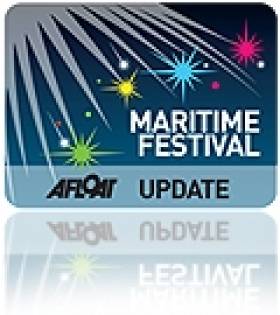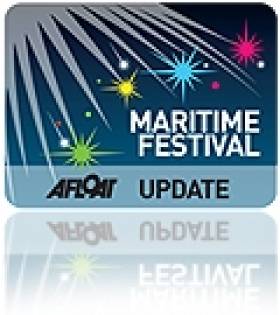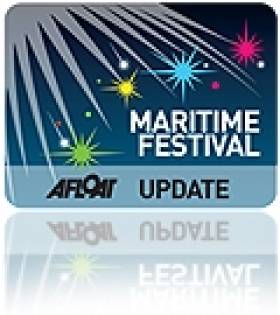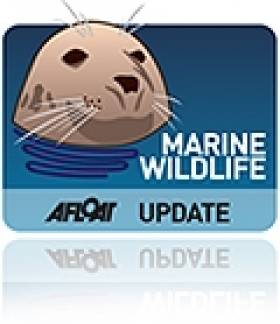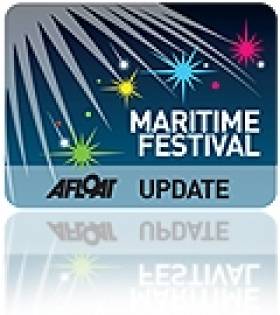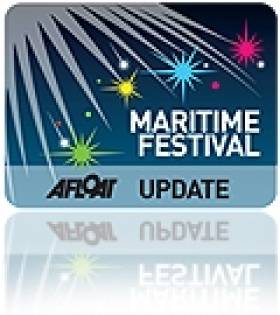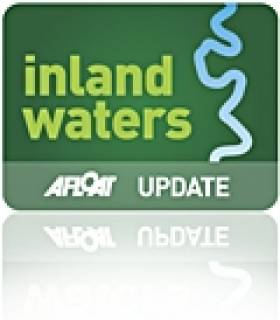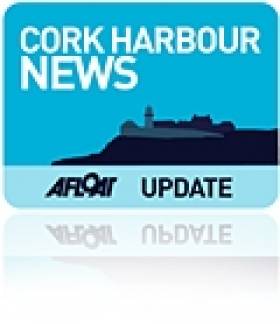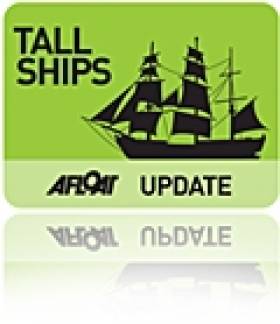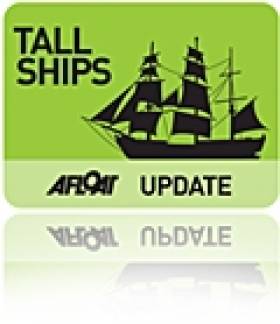Displaying items by tag: Maritime Festivals
Stormy Stan Sails In For Arklow's Gathering of the Fleet
#MaritimeFestivals - Stormy Stan sailed into Arklow aboard tall ship Ruth recently as part of the build up to Arklow RNLI’s Gathering of the Fleet Maritime Festival.
This August Bank Holiday weekend, Arklow RNLI and Arklow Harbour will play host to vessels of all shapes and sizes from tall ships such as Ruth to Naval Service vessels, vintage and prototype RNLI lifeboats, emergency service vessels and visiting boats from all around the UK, Ireland and further afield for the fundraising festival, which is now over 50 years old and continues to go from strength to strength.
Boat trips, kayaking and windsurfing opportunities will be up for grabs, as well as the special attraction of the Thundercat Experience, where visitors can head out on the water aboard a Thundercat racing boat.
There will be aerial attractions too, with a flying visit by the Garda Air Support Unit and the regular Air Sea Rescue Display with the Irish Coast Guard's Rescue 117 helicopter.
And that's not to mention the activities or landlubbers such as the carnival, food and craft stalls, live music, model boats, emergency service demonstrations and vintage vehicles.
Arklow RNLI volunteer lifeboat press officer Mark Corcoran said: "This weekend really is a must for maritime enthusiasts and all the family. Almost all of the events are free. This is our opportunity to put something back in our town.
"Without our communities continued support we couldn’t continue, so make sure to come down to Arklow this August Bank Holiday weekend for the Gathering of the Fleet-Arklow Maritime Festival."
He added: "There really is something for everybody, so put it in the calendar."
Full details of the festival will be available on the festival's Facebook page, where anyone with a vessel who wants to take part in the festival can make contact. There is also an opportunity for any novice or experienced sailors to arrive at the festival aboard a tall ship – e-mail [email protected] for further details.
Galway Expects Crowds For First Sea Festival
#Festivals - "Tens of thousands" of visitors are expected to flock to the City of the Tribes later this month for the first Galway Sea Festival over the June bank holiday weekend, according to the Galway Advertiser.
Dubbed the 'Mini-Volvo' by locals, the four-day event from 31 May till 3 June is hoped to recreate the celebratory atmosphere of last summer's successful Volvo Ocean Race finale, with a wide range of events both on and off the waters of Galway Bay.
Highlights include the festival regatta led by the Galway Bay Sailing Club's parades of sail on the Friday and Saturday evenings, and a traditional boat regatta by Badoiri na Cladaigh.
Watersports enthusiasts can get a taste of canoeing, diving, sea kayaking and windsurfing over the weekend, which also coincides with World Oceans Day - with family-friendly activities at the Galway Atlantaquaria on Sunday 2 June - and the International Canoe Polo Championships at Claddagh Basin.
Preceding the festival on Thursday 30 May will be the Bright Blue Sea Conference, a major international symposium on marine science, renewable energy, the environment and the 'blue economy'.
Last month it was reported that the Galway Sea Festival received the financial backing of Galway City Council, spurred by its aims to promote Galway as a maritime destination or commerce and tourism.
The Galway Advertiser has much more on the festival HERE.
An Tostál Fest Rescheduled For End of May
#AnTostal - Galway's An Tostál maritime festival will take place on 26 May after strong winds forced the postponement of the originally scheduled date last Sunday, according to the Galway Independent.
Cian O’Lorcáin of the organisers said the decision to delay the event was made "for the benefit of water safety. We were really thinking of the crews on the water because, with the winds, it could have proved hazardous...
"Safety is the number one thing for us so when that couldn't be guaranteed, we decided to postpone."
As previously reported on Afloat.ie, the festival - reactivated in 2011 after a 50-year gap - celebrates Galway's maritime traditions with currach racing along the Salthill promenade. This year's event is also set to feature a Galway Hooker parade of sail.
Dingle's Fungie May Have Come From British Dolphinarium
#Fungie - An Irish marine expert suspects that Dingle's most famous resident may be an escapee from a British dolphinarium.
Dingle Oceanworld director Kevin Flannery told the Irish Independent that Fungie the dolphin could have slipped through the sluice gates of any one of a number of dolphinariums on the south coast of England amid "huge objections to holding marine animals in captivity".
As previously reported on Afloat.ie, the male bottlenose dolphin appeared out of nowhere in Dingle's harbour in 1983 and has made his home there ever since.
In the three decades from then he has been credited with having "rescued" the village as his frolics brings countless tourists to the peninsula every year, as Flannery told the Irish Examiner.
This week's Féile na Bealtaine in Dingle celebrates the 30th anniversary of the arrival of the Kerry village's cetacean mascot, and many visitors are expected to line up for boat trips out of the harbour to meet him face to face.
While the Irish Whale and Dolphin Group (IWDG) doesn't recommend swimming with a wild dolphin such as Fungie, the group's Nick Massett describes him as "friendly, intelligent, and very aware of where people [are] in the water".
Among the festival activities this week will be a film screening and exhibits paying tribute to Ireland's own 'Flipper'.
Féile na Bealtaine runs from 2-6 May with events throughout the Dingle Peninsula.
Arrive By Sea!...to the Dublin Bay Prawn Festival
#FestivalExcursion-Those heading for the Dublin Bay Prawn Maritime Festival (26-28 April) in Howth may consider an alternative and new way of reaching the north Co. Dublin fishing harbour with Dublin Bay Cruises which began operations last week, writes Jehan Ashmore.
The excursions run between Dun Laoghaire (East Pier) and Howth and are offered as a one-way trip (in either direction) between the harbours.
Passengers will be able to make their way back to the city-centre from either Dun Laoghaire or Howth harbours by taking the DART train (concessionary price) or use of other public transport links.
For the festival, Dublin Bay Cruises are also providing special 'Prawn Festival Cruises' on Saturday (27 April) with cruises departing Howth Harbour (at 13.30 and 15.30). These cruises will head out around Howth Peninsula and into Dublin Bay before returning back to the harbour.
All the excursions are operated by 'St. Bridget', a 26m steel-hulled vessel with a capacity for around 100 passengers and which has a bar facility serving light refreshments.
In addition there are shorter trips from Howth Harbour to Ireland's Eye and 'round' the island excursions which are operated by Ireland's Eye Ferries and Island Ferries.
Also taking place on the Saturday, as previously reported on Afloat.ie, there is to be a Prawn Push in aid of Howth RNLI beginning at 3pm.
RNLI Mechanic Plots Online Course For Rosses Point Shanty Fest
#MaritimeFestivals - Organisers of the Rosses Point Shanty Festival didn't have far to cast their net when they needed someone to design their new website.
The maritime festival in aid of Sligo Bay RNLI landed a handy catch in a web designer with the sea flowing through his veins.
Not only is Daryl Ewing the mechanic for Sligo Bay's lifeboat and skipper of Ewing’s Sea Angling and Boat Charters, he is also a dab hand at plotting a course in web design.
The new website gives all the details for Rosses Point’s big event from 14 to 16 June, including the programme and details on performers who are drawn from throughout Europe.
As previously reported on Afloat.ie, the festival is now in its fourth year and has become Ireland’s premier shanty event.
"It’s great to see such a brilliant festival celebrating one of Sligo's best assets and maritime history," said Ewing. "I hope it continues long into the future, and encourage everybody to come out, take part and join in the festivities for such a great cause."
Entries Open For IUSRU Raft Race at Docklands Summer Fest
#InlandWaterways - The Irish Underwater Search and Recovery Unit (IUSRU) has announced details of its Raft Race as part of the Waterways Ireland Docklands Summer Festival.
Entry is €25 per person with four persons per raft for the day of wackiness on the water at Grand Canal Basin on 19 May.
And for those who can't build their own raft in time, prebuilt rafts can be supplied by the organisers.
More details of the event can be had from the IUSRU at 087 975 8656 or [email protected].
The complete programme of events for the Docklands Summer Festival will be posted on the official website shortly.
Cork Harbour Open Weekend Events Announced
#CORK HARBOUR - Due to the success of previous years’ festivals, Cork Harbour Open Day has now been expanded to a two-day Open Weekend for 2012, with activities for all ages taking place on Saturday 15 and Sunday 16 September.
The open weekend is a great opportunity for people to see exactly what Cork Harbour has to offer, and this year is no exception with the second largest natural harbour in the world playing host to the annual Cobh-to-Blackrock sailing race, kayaking on the River Lee and crab fishing in Cobh, while in Cork city the Naval Service vessel LE Ciara will be open to the public for free tours on both the Saturday and Sunday.
Visitors to Ringaskiddy over the weekend will be given the opportunity to go on a free guided tour around the National Maritime College of Ireland (NMCI) and see its panoramic bridge ship simulators, the survival pool and the marine workshops.
Also running in the NMCI will be free screenings of finalist entries of 8 Minutes: The Ford Short Film Competition. Part of the Titanic 100 event, the competition saw hundreds of entries from film-makers across Ireland who submitted short films of eight minutes in length based on a Titanic theme. All 12 finalists’ entries will be screened over the weekend.
To celebrate Cork Harbour Open Weekend, Spike Island is offering a family day out on the Island with live music, children’s entertainers and an opportunity to walk on the recently completed walking trail around the perimeter of Fort Mitchell with stunning views of Cork Harbour. Military exhibitions will also be on display. Visitors to the island are being encouraged to bring their own picnic. Guided Walking Tours of Fort Mitchell are also available at a 50% discount of the normal rate over the weekend. Boat rides will operate from Kennedy Pier in Cobh to the Island.
In Crosshaven, Camden Fort Meagher will be hosting military re-enactments on both days. On Sunday a family day will be held featuring children’s entertainers, a fancy dress competition and live music.
In Cobh, there will be crab fishing at the promenade from 3pm–5pm on the Saturday while Sunday will see a ‘Life Along the Seashore’ walk at 3pm. Also in Cobh on both Saturday and Sunday will be the ‘Great Island, Great Harbour, Great Ships, Great Puzzle’ treasure hunt.
Blackrock Castle Observatory will present its theatrical tours on Saturday and Sunday, bringing the colourful story of the castle to life from 400 years ago to present day. It’s a great venue for all the family and a superb location to watch the Cobh-to-Blackrock sailing race as the yachts head up the river.
Also taking place on the Saturday is the Emergency, Voluntary and Statutory Services Exhibition which will see demonstrations and drills showcasing the best of the emergency services. Organisers will simulate crash scenes, perform fire-fighting displays, take to the River Lee in sea riders to perform RIB displays and mount a simulated rescue operation in which rescue personnel will abseil from buildings.
Aimed at embracing all that Cork Harbour has to offer, the Cork Harbour Open Weekend aims to raise awareness of the different activities available for people in the harbour both on and off the water. It’s a great day for all the family with many events free to everyone.
The idea for a Harbour Open Day, now extended to a full weekend, emerged from discussions between various stakeholders involved in the development and implementation of the Integrated Strategy for the Harbour in 2007. This has been taken forward by the Harbour Management Focus Group (HMFG) which meets quarterly to exchange information on Harbour issues. The HMFG working group comprising representatives from UCC, City and County Councils and the Port of Cork set about working together to engage users of the Harbour and to organise the Open Day.
For more information on Cork Harbour Open Weekend and to view the full programme of events visit www.corkharbour.ie.
Teen Rescued from Docklands During Tall Ships Festival Prep
#TALL SHIPS - A 15-year-old boy was rescued from the water at Dublin's Grand Canal Dock yesterday after getting into difficulty while swimming.
According to RTÉ News, the teenager from Blanchardstown was swimming with a number of friends at Hanover Quay amid preparations for the Tall Ships Races Festival when he went missing around lunchtime yesterday.
Fire officers reportedly retrieved the boy from the water and gave him CPR on the quayside before he was transferred to St Vincent's Hospital in Merrion.
The Irish Times reports that the teen was in the area to volunteer with the Kings of Concrete urban sports display group as part of the Tall Ships Races events.
Organisers later confirmed that the boy was not preparing for his volunteer work at the time of the incident, which underlines the importance of water safety for all volunteers and visitors at the Docklands festival starting tomorrow.
Safety is also paramount aboard the tall ships fleet as they make their way to the capital, with damage inflicted on nearly all the more than 40 vessels in stormy conditions in the Bay of Biscay, according to the Irish Independent.
Ecuadorian naval ship the Guayas suffered eight ripped sails in the storm, but the worst damage was sustained by the Polish schooner Captain Borchardt, which arrived in Dublin with a broken mast.
However, master of the skip Janus Zbierajewski jokingly described the experience as "absolutely perfect weather".
The bad weather was enough to force at least once ship to abandon the final race leg, with Sail Training Association flagship STS Pogoria arriving in Dublin Port some days ahead of schedule.
Tall Ships Dublin Organisers Launch Festival Programme
#TALL SHIPS - Preparations are well underway for the arrival of the Tall Ships Races Festival Dublin, one of the most anticipated events of the year which kicks off this Thursday 23 August.
Presented by the Polish port city of Szczecin and organised by Sail Training International, the festival in Dublin's Docklands aims to top last year's celebrations in Waterford and will see the city come alive with a spectacular atmosphere both on and off the water.
Some of the 40 magnificent Tall Ships - such as the barque STS Pogoria – have already begun to arrive in Dublin Port at the end of the prestigious international race and will line the North and South of the River Liffey as the centerpiece of the four-day free festival.
Along with Waterways Ireland's programme at Grand Canal Dock as previously reported on Afloat.ie, organisers Dublin City Council and the Dublin Port Company have scheduled an impressive series of events to herald the arrival of the fleet that will cater for all tastes and ages and will showcase Dublin at its very best.
And don't forget you can catch all the sights on the Allianz All-Aboard Liffey Cruise, with seats available for just €1!
The highlight of the weekend is bound to be the stunning Parade of Sail as the ships depart the capital on Sunday 26 August from 11am.
Friday afternoon will also see thousands of Tall Ships crew members from all four corners of the globe march up Dublin’s north quays from Point Village for what promises to be a vibrant, colourful spectacle to kick off the weekend, finishing at The Custom House for a special prize giving ceremony with musical accompaniment from the the Garda Band, the Tallaght Youth Band and the Army No 1 Band.
Also taking place is a series of maritime-themed readings and talks in various locations, including a barge, which will celebrate the history and some of the personal tales from Dublin’s Docklands.
Celebrated writers and historians such as Peter Sheridan, Theo Dorgan, Anne Chambers, Turtle Bunbury and the local Dockers Preservation Society will regale their audiences with tales of Dublin City, its port, their sailing experiences, excerpts from their books. See www.dublintallships.ie for times and e-mail your name and title of talk to [email protected] to be placed on the guest list - first come, first served.
Complementing the maritime element, the festival will feature 55 music acts over the four days including the Undertones, Ash and Therapy? at the Bulmers Live Music Dock at George’s Dock. And the entertainment continues into the evening with an open-air floating cinema showing classics such as Jaws and The Life Aquatic.
More than 100 performance acts from trapeze artists to wake boarding will wow the crowds on both sides of the river each afternoon, not to mention food and craft markets, walking literary tours and a funfair.
On the south quays, Grand Canal Dock will host a family zone, while Hanover Quay will come alive with skateboarding, parkour, beatboxing and music with the spectacular Kings of Concrete. Visitors can also try their hand at cable kayaking, pedalo boats, wakeboarding and crazy golf on a pontoon at Grand Canal Dock with Waterways Ireland and Surf Dock.
On the other side, food demonstrations from some of Ireland’s leading chefs will take place at the Theatre of Food in Linear Park. And the Festival Hub at CHQ will have a more relaxed atmosphere with a beautiful black and white photography exhibition from the Dublin Docklands Preservation Society, a range of workshops including yoga and 'upcycling' an and exhibition of Viking Dublin in the vaults.
Full details of events and how to get to the Tall Ships Races Festival can be found at www.dublintallships.ie. Gardaí are appealing for visitors to use public transport into the city due to a number of road closures, and have warned that anti-social behaviour including pubic drinking will not be tolerated.


























